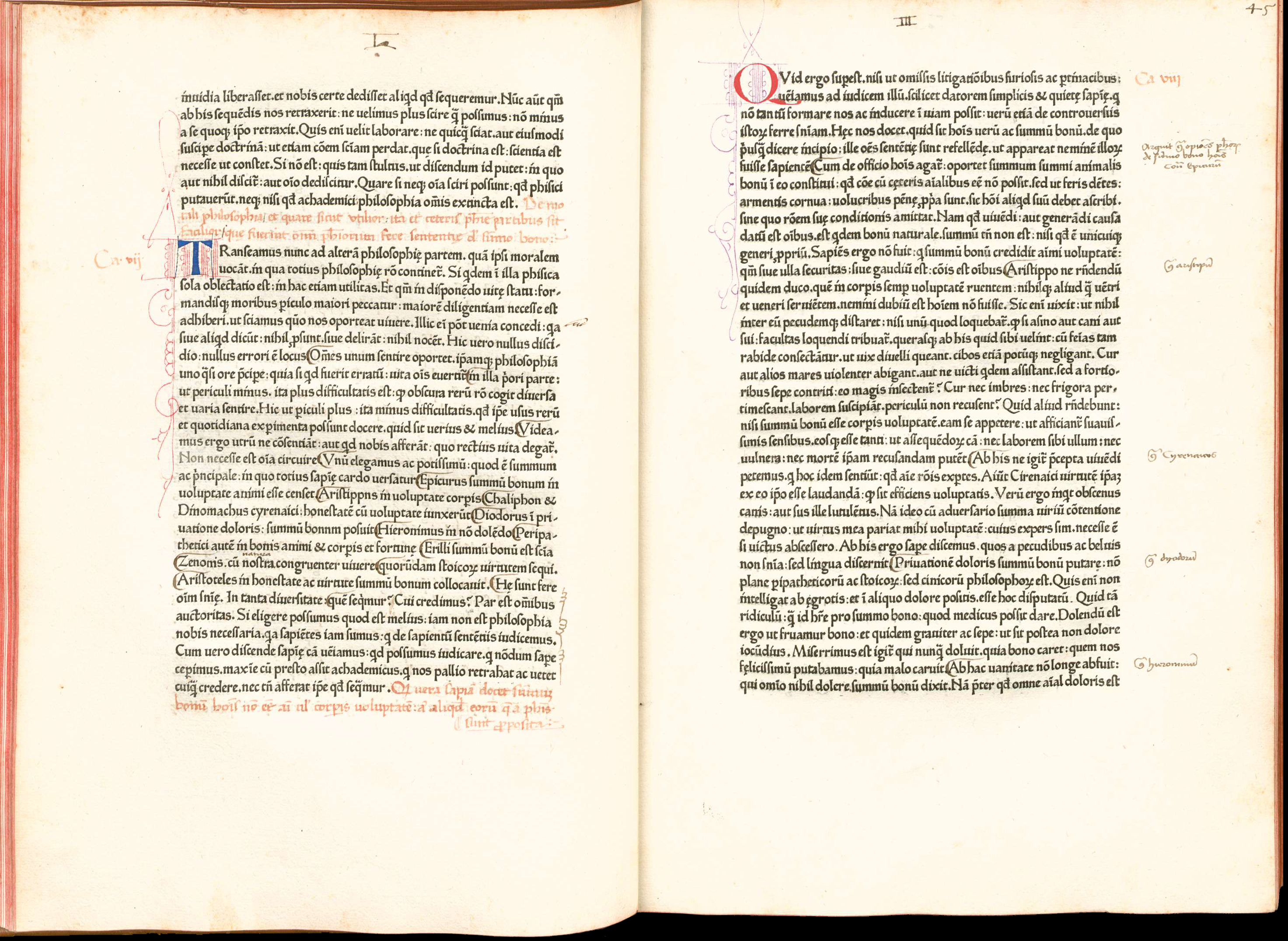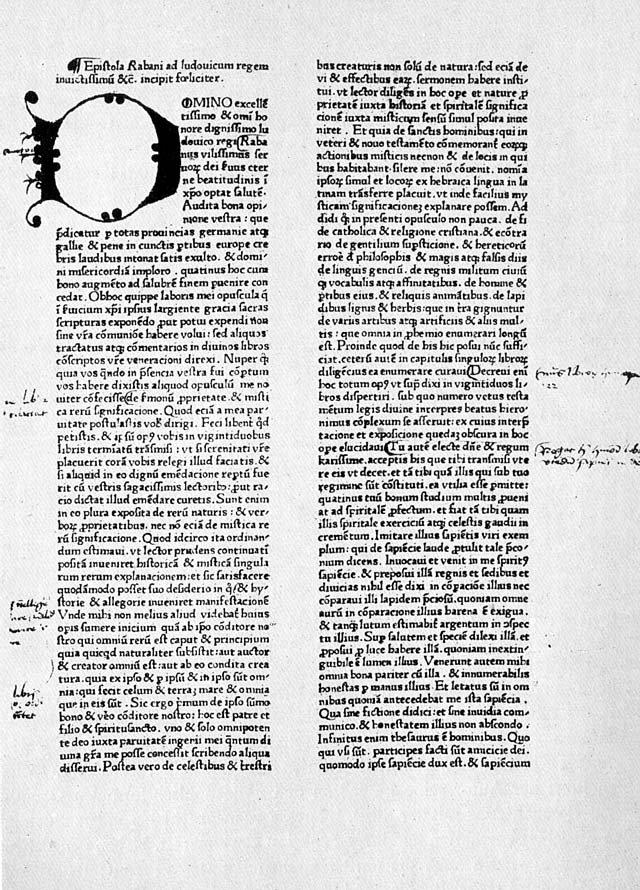|
Editio Princeps (Latin)
In classical scholarship, the ''editio princeps'' (plural: ''editiones principes'') of a work is the first printed edition of the work, that previously had existed only in manuscripts, which could be circulated only after being copied by hand. The following is a list of Latin literature works. Latin works 15th century 16th century 17th century 18th - 20th century Latin Translations References {{reflist Textual scholarship Latin-language literature Lists of firsts Lists of books ... [...More Info...] [...Related Items...] OR: [Wikipedia] [Google] [Baidu] |
Classical Scholarship
Classics or classical studies is the study of classical antiquity. In the Western world, classics traditionally refers to the study of Classical Greek and Roman literature and their related original languages, Ancient Greek and Latin. Classics also includes Greco-Roman philosophy, history, archaeology, anthropology, Ancient art, art, Classical mythology, mythology and society as secondary subjects. In Western civilization, the study of the Ancient Greece, Greek and Roman Empire, Roman classics was traditionally considered to be the foundation of the humanities, and has, therefore, traditionally been the cornerstone of a typical elite European education. Etymology The word ''classics'' is derived from the Latin adjective ''wikt:classicus, classicus'', meaning "belonging to the highest class of citizens." The word was originally used to describe the members of the Patrician (ancient Rome), Patricians, the highest class in ancient Rome. By the 2nd century AD the word was used in ... [...More Info...] [...Related Items...] OR: [Wikipedia] [Google] [Baidu] |
Arnold Pannartz And Konrad Sweynheim
Arnold Pannartz and Conrad Sweynheym were two printers of the 15th century, associated with Johannes Gutenberg and the use of his invention, the mechanical movable-type printing press. Backgrounds Arnold Pannartz was, perhaps, a native of Prague, and Conrad Sweynheym of Eltville near Mainz. Gottfried Zedler believed (''Gutenberg-Forschungen,'' 1901) that Sweynheym worked at Eltville with Johannes Gutenberg in 1461–1464. Whether Pannartz had been connected with Sweynheym in Germany is not known. It is certain that the two brought Gutenberg's invention, the mechanical movable-type printing press, to Italy. Pannartz died about 1476, Sweynheym in 1477. Printing work The Benedictine abbey of Subiaco was the cradle of Italian printing. Probably Cardinal Giovanni Turrecremata, who was Abbot ''in commendam'' of Subiaco, summoned the two printers there. They came in 1464. The first book that they printed at Subiaco was a Donatus; it has not, however, been preserved. The first book ... [...More Info...] [...Related Items...] OR: [Wikipedia] [Google] [Baidu] |
Teodoro De Lellis
Teodoro de Lellis or Teodoro Lelli (died 1466) was a Roman Catholic prelate who served as Bishop of Treviso (1464–1466) ''(in Latin)'' and Bishop of Feltre (1462–1464). ''(in Latin)'' Biography On 15 February 1462, Teodoro de Lellis was appointed during the papacy of Pope Pius II as Bishop of Feltre. On 17 September 1464, he was appointed during the papacy of Pope Paul II as Bishop of Treviso The Diocese of Treviso ( la, Dioecesis Tarvisina) is Latin Church ecclesiastical territory or diocese of the Catholic Church in the Veneto, Italy. It is a suffragan diocese in the ecclesiastical province of the metropolitan Patriarchate of Venic .... He served as Bishop of Treviso until his death on 31 March 1466. References External links and additional sources * (for Chronology of Bishops) * (for Chronology of Bishops) * (for Chronology of Bishops) * (for Chronology of Bishops) 15th-century Italian Roman Catholic bishops Bishops appointed by Pope ... [...More Info...] [...Related Items...] OR: [Wikipedia] [Google] [Baidu] |
Jerome
Jerome (; la, Eusebius Sophronius Hieronymus; grc-gre, Εὐσέβιος Σωφρόνιος Ἱερώνυμος; – 30 September 420), also known as Jerome of Stridon, was a Christian priest, confessor, theologian, and historian; he is commonly known as Saint Jerome. Jerome was born at Stridon, a village near Emona on the border of Dalmatia and Pannonia. He is best known for his translation of the Bible into Latin (the translation that became known as the Vulgate) and his commentaries on the whole Bible. Jerome attempted to create a translation of the Old Testament based on a Hebrew version, rather than the Septuagint, as Latin Bible translations used to be performed before him. His list of writings is extensive, and beside his biblical works, he wrote polemical and historical essays, always from a theologian's perspective. Jerome was known for his teachings on Christian moral life, especially to those living in cosmopolitan centers such as Rome. In many cases, he fo ... [...More Info...] [...Related Items...] OR: [Wikipedia] [Google] [Baidu] |
Adolf Rusch
Adolf Rusch von Ingweiler (ca. 1435 – 26 May 1489 in Straßburg) was a notable German printer and publisher. He was the first printer north of the Alps to print in Antiqua. Life and work Rusch was probably born at Ingweiler in Alsace. Before 1488 he married Salome Mentelin, a daughter of the well-known Straßburg printer Johannes Mentelin, in whose printing shop he assisted. In the ''Rationale divinorum officium'', printed by Rusch in or before 1474, he was the first to use the Antiqua type which had originated in Italy; in this type Rusch issued Latin classics, including works by Plutarch and Seneca Seneca may refer to: People and language * Seneca (name), a list of people with either the given name or surname * Seneca people, one of the six Iroquois tribes of North America ** Seneca language, the language of the Seneca people Places Extrat .... Jointly with Mentelin he produced theological and medical works, in the Mentelin typeface. Rusch left behind an extensive corr ... [...More Info...] [...Related Items...] OR: [Wikipedia] [Google] [Baidu] |
Rabanus Maurus
Rabanus Maurus Magnentius ( 780 – 4 February 856), also known as Hrabanus or Rhabanus, was a Frankish Benedictine monk, theologian, poet, encyclopedist and military writer who became archbishop of Mainz in East Francia. He was the author of the encyclopaedia ''De rerum naturis'' (''"On the Natures of Things"''). He also wrote treatises on education and grammar and commentaries on the Bible. He was one of the most prominent teachers and writers of the Carolingian age, and was called "Praeceptor Germaniae", or "the teacher of Germany". In the most recent edition of the Roman Martyrology ('' Martyrologium Romanum'', 2004, pp. 133), his feast is given as 4 February and he is qualified as a Saint ('sanctus'). Life Rabanus was born of noble parents in Mainz. The date of his birth remains uncertain, but in 801 he was ordained a deacon at Benedictine Abbey of Fulda in Hesse, where he had been sent to school and had become a monk. At the insistence of Ratgar, his abbot, he went t ... [...More Info...] [...Related Items...] OR: [Wikipedia] [Google] [Baidu] |
Milan
Milan ( , , Lombard language, Lombard: ; it, Milano ) is a city in northern Italy, capital of Lombardy, and the List of cities in Italy, second-most populous city proper in Italy after Rome. The city proper has a population of about 1.4 million, while its Metropolitan City of Milan, metropolitan city has 3.26 million inhabitants. Its continuously built-up List of urban areas in the European Union, urban area (whose outer suburbs extend well beyond the boundaries of the administrative Metropolitan cities of Italy, metropolitan city and even stretch into the nearby country of Switzerland) is the fourth largest in the EU with 5.27 million inhabitants. According to national sources, the population within the wider Milan metropolitan area (also known as Greater Milan), is estimated between 8.2 million and 12.5 million making it by far the List of metropolitan areas of Italy, largest metropolitan area in Italy and List of metropolitan areas in Europe, one of ... [...More Info...] [...Related Items...] OR: [Wikipedia] [Google] [Baidu] |
Confessions (St
Confessions are acknowledgements of facts by those who would have otherwise preferred to keep those facts hidden. Confessions may also refer to: Film, television, and radio * ''Confessions'' (1925 film), a British silent film * ''Confessions'' (2010 film), a Japanese film * ''The Confessions'' (film) (''Le confessioni''), a 2016 Italian film * Confessions series, a 1970s series of film adaptations of novels by Christopher Wood * "Confessions" (''Arrow''), a 2019 television episode * "Confessions" (''Breaking Bad''), a 2013 television episode * "Confessions" (''Roseanne''), a 1990 television episode * ''Confessions'' (radio programme), a British radio feature presented by Simon Mayo Literature * ''Confessions'' (Augustine), a 4th-century autobiographical work by St. Augustine of Hippo * ''Confession'' (Bakunin), an 1851 autobiographical work by Mikhail Bakunin * ''Confessions'' (Rousseau), a 1782–1789 autobiography by Jean-Jacques Rousseau * Confessions series, a 1970 ... [...More Info...] [...Related Items...] OR: [Wikipedia] [Google] [Baidu] |
Strasbourg
Strasbourg (, , ; german: Straßburg ; gsw, label=Bas Rhin Bas-Rhin (; Alsatian: ''Unterelsàss'', ' or '; traditional german: links=no, Niederrhein; en, Lower Rhine) is a department in Alsace which is a part of the Grand Est super-region of France. The name means 'Lower Rhine', referring to its lowe ... Alsatian dialect, Alsatian, Strossburi , gsw, label=Haut Rhin Alsatian dialect, Alsatian, Strossburig ) is the Prefectures in France, prefecture and largest city of the Grand Est Regions of France, region of Geography of France, eastern France and the Seat of the European Parliament in Strasbourg, official seat of the European Parliament. Located at the France–Germany border, border with Germany in the historic region of Alsace, it is the prefecture of the Bas-Rhin Departments of France, department. In 2019, the city proper had 287,228 inhabitants and both the Eurométropole de Strasbourg (Greater Strasbourg) and the Arrondissement of Strasbourg had 505,272 inhabita ... [...More Info...] [...Related Items...] OR: [Wikipedia] [Google] [Baidu] |
Johannes Mentelin
Johannes Mentelin, sometimes also spelled Mentlin, (born around 1410 in Schlettstadt, today Sélestat; died December 12, 1478 in Strasbourg) was a pioneering German book printer and bookseller active during the period during which incunabula were printed. In 1466, he published the first printed Bible in the German language, the . Life In 1447, Johannes Mentelin gained the rights of a Strasbourg citizen. He was first a ''Goldschreiber'' (calligrapher and book scribe) by profession and worked in addition as an episcopal notary. Exactly when and where he learned the technique of book printing is not known. Since at the end of the 1450s, when Mentelin founded his Strasbourg printery, there was still no other place where printing was done besides Mainz, it is likely that he either got his knowledge directly there or through a middleman. Such a go-between might have been Heinrich Eggestein. It is suspected that he had been introduced to the trade of book printing during his stay i ... [...More Info...] [...Related Items...] OR: [Wikipedia] [Google] [Baidu] |
Augustine Of Hippo
Augustine of Hippo ( , ; la, Aurelius Augustinus Hipponensis; 13 November 354 – 28 August 430), also known as Saint Augustine, was a theologian and philosopher of Berber origin and the bishop of Hippo Regius in Numidia, Roman North Africa. His writings influenced the development of Western philosophy and Western Christianity, and he is viewed as one of the most important Church Fathers of the Latin Church in the Patristic Period. His many important works include '' The City of God'', '' On Christian Doctrine'', and '' Confessions''. According to his contemporary, Jerome, Augustine "established anew the ancient Faith". In his youth he was drawn to the eclectic Manichaean faith, and later to the Hellenistic philosophy of Neoplatonism. After his conversion to Christianity and baptism in 386, Augustine developed his own approach to philosophy and theology, accommodating a variety of methods and perspectives. Believing the grace of Christ was indispensable to human fr ... [...More Info...] [...Related Items...] OR: [Wikipedia] [Google] [Baidu] |







